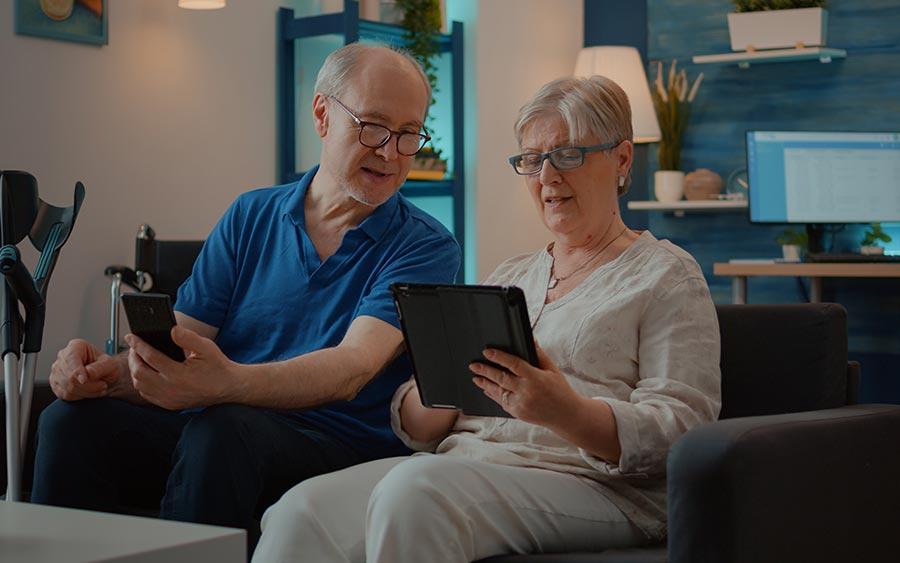First impressions are everything, especially in the digital age. When it comes to healthcare websites, a visually appealing design is just the tip of the iceberg. It’s not just about aesthetics; it’s about building trust and credibility with your audience. In this blog post, we’ll dive into why healthcare web design goes beyond looks and explore how it plays a crucial role in establishing trust with patients. So grab your stethoscope (metaphorically speaking) and let’s uncover the secrets to creating a website that instills confidence in your visitors!

When it comes to HealthCare Web Design, first impressions are vital. Think about it: when you visit a website for the first time, what do you notice? The design, layout, and overall user experience play a significant role in shaping your initial perception. If a website looks outdated or cluttered, chances are you won’t stick around for long.
In the healthcare industry, where trust is paramount, first impressions can make or break a potential patient’s decision to seek care. A well-designed website conveys professionalism and competence right from the start. It shows that your organization values quality and cares about providing an exceptional online experience for visitors.
But it’s not just about aesthetics; usability matters too. Is your website easy to navigate? Can users find the information they’re looking for quickly? A smooth user interface enhances the overall browsing experience and helps visitors feel confident in their ability to access necessary resources.
Remember that patients often turn to the internet for health-related information before making important decisions regarding their well-being. By creating an intuitive and visually appealing website, you position yourself as a trusted source of reliable information—resource patients can depend on during their healthcare journey.
So don’t underestimate the power of those precious seconds when someone lands on your site for the very first time. Invest in professional web design that reflects who you are as a healthcare provider and sets the tone for building trust with potential patients.
The credibility of healthcare websites is crucial in today’s digital age. When it comes to matters of health, people are understandably cautious and want to ensure they are getting accurate and reliable information. That’s why the credibility of a healthcare website plays a vital role in building trust with users.
One aspect that contributes to the credibility of a healthcare website is its design. A well-designed website gives off an impression of professionalism and expertise. It shows that the organization behind it takes its online presence seriously and cares about providing valuable information to its audience.
Another factor that affects credibility is the accuracy and relevance of content on the website. Healthcare websites should strive to provide up-to-date and evidence-based information, backed by reputable sources. Users need assurance that what they find on these sites is trustworthy and not misleading or inaccurate.
In addition, user experience also plays a part in establishing credibility. A poorly designed website with confusing navigation or slow loading times can leave users feeling frustrated and skeptical about the reliability of the information provided.
To enhance credibility, healthcare websites should prioritize transparency by clearly displaying contact information, credentials of medical professionals involved, privacy policies, and any affiliations or certifications relevant to their field.
Regularly updating content with fresh articles, blog posts, or news updates will show visitors that the website is actively maintained and committed to providing current information.
By focusing on creating a visually appealing design paired with accurate content and user-friendly features, healthcare websites can establish themselves as credible sources of health-related information.
Remember: The goal here isn’t just aesthetics; it’s about earning trust through knowledgeable design choices!
The healthcare industry has undergone a significant shift in recent years, with more and more patients turning to the Internet for medical information and services. As a result, the importance of web design in this industry cannot be overstated. A well-designed healthcare website not only serves as an online representation of a healthcare provider or organization but also plays a crucial role in establishing trust and credibility among potential patients.
A visually appealing and user-friendly website design creates a positive first impression. When visitors land on your site, they should immediately feel that it is professional, modern, and reliable. This can be achieved through clean layouts, intuitive navigation menus, and high-quality images that reflect the nature of your practice or facility.
Furthermore, effective web design enhances the overall user experience by making it easy for visitors to find the information they need quickly. Patients often visit healthcare websites seeking specific details about services offered, contact information, appointment booking options, or even patient testimonials. If these elements are buried within complex navigation structures or cluttered pages, users may become frustrated and leave without taking any desired action.
Moreover, a well-designed healthcare website instills confidence in potential patients by providing accurate content presented in an organized manner. It is essential to ensure that all information displayed is up-to-date and relevant so that users can make informed decisions about their health needs.
In addition to aesthetics and functionality, web design plays a vital role in ensuring compliance with privacy regulations such as HIPAA (Health Insurance Portability & Accountability Act). Implementing secure data encryption protocols is crucial when handling sensitive patient information online.
Overall, the importance of web design goes beyond mere aesthetics – it directly impacts how potential patients perceive your organization’s professionalism、trustworthiness、and commitment to providing quality care. By investing time、effort、and resources into creating an exceptional web presence、healthcare providers can build trust among online audiences while effectively communicating their expertise、services and values.
Creating a trustworthy and credible HealthCare Web Design is crucial in gaining the trust of patients and establishing your reputation as a reliable source of information. Here are some key steps to consider when designing your healthcare website:
1. Clear and User-Friendly Navigation: Ensure that visitors can easily navigate through your website by organizing content logically, using clear headings, and providing intuitive menus. This will help them find the information they need quickly.
2. Professional Design: Opt for a clean and professional design that reflects the seriousness of the healthcare industry. Avoid cluttered layouts or flashy graphics that may distract users from finding relevant information.
3. Consistent Branding: Use consistent branding elements such as colors, fonts, and logos throughout your website to create a cohesive look and feel. This helps build recognition and reinforces credibility.
4. Relevant Content: Provide accurate, up-to-date, and reliable content on your website to establish yourself as an authoritative source in the healthcare field. Include information about services offered, medical professionals’ qualifications, patient testimonials (with consent), and educational resources.
5. Easy Contact Information: Make it easy for visitors to contact you by prominently displaying contact details like phone numbers, email addresses, or online appointment booking forms on every page.
6. Mobile Responsiveness: With more people accessing websites via smartphones or tablets than ever before, ensure that your site is mobile-friendly for seamless browsing across different devices.
Following these guidelines in creating a trustworthy and credible healthcare website design will not only attract potential patients but also nurture long-term relationships based on trust with existing ones!
Common design mistakes can significantly impact the credibility and trustworthiness of a healthcare website. By avoiding these errors, you can ensure that your website effectively conveys professionalism and reliability to users.
One common mistake is cluttered or busy designs. When a website is overwhelmed with excessive graphics, pop-ups, or ads, it becomes difficult for visitors to navigate and find the information they need. Keep your design clean and uncluttered, focusing on simplicity and ease of use.
Another mistake to avoid is using generic stock photos. While images can enhance the visual appeal of a website, using generic or irrelevant stock photos can detract from its credibility. Instead, opt for authentic images that reflect your specific healthcare practice or industry.
Poor navigation is another pitfall to steer clear of. Users should be able to easily access different sections of your site without confusion or frustration. Clear menu options and intuitive navigation will improve user experience and encourage them to stay on your site longer.
Additionally, neglecting mobile optimization is a major oversight in today’s digital landscape. With more people accessing websites through their smartphones or tablets, it’s crucial that your healthcare website displays properly across all devices. Responsive design ensures that users have a seamless experience regardless of the device they’re using.
Failing to include relevant contact information such as phone numbers and email addresses can lead to mistrust among visitors. Make sure this information is prominently displayed so that potential patients feel confident contacting you for further inquiries or appointments.
By avoiding these common design mistakes and implementing best practices in web design for healthcare websites, you can create an online presence that inspires trust and credibility among users seeking reliable medical information and services.
In today’s digital age, a strong online presence is crucial for healthcare providers. A well-designed website goes beyond aesthetics and plays a vital role in building trust and credibility with patients. By ensuring that your HealthCare Web Design is visually appealing, user-friendly, and informative, you can establish yourself as a reputable source of information and care.
First impressions matter, and your website is often the first point of contact for potential patients. A poorly designed or outdated site can deter visitors from exploring further or seeking your services. On the other hand, a professionally designed website instills confidence in users, making them more likely to trust your expertise and choose you as their preferred healthcare provider.
Credibility is paramount in the healthcare industry. Patients want reassurance that they are receiving accurate information from reliable sources. An effective web design strategy includes incorporating elements such as testimonials, certifications, awards, and affiliations to showcase your expertise and build credibility.
A well-designed healthcare website should prioritize user experience by providing easy navigation, clear calls-to-action (CTAs), fast loading times, mobile responsiveness, and HIPAA compliance when dealing with sensitive patient data. This ensures that visitors have a seamless experience while accessing important information or scheduling appointments.
While it’s important to maintain a professional online presence, it’s also important to be mindful of the design and usability of your healthcare website. By following these simple tips, you can create a site that is both visually appealing and informative, encouraging patients to seek out your services and trust your expertise. For free consultation call 1-916-358-6449

Why Hiring an SEO Professional in Roseville CA Can Transform Your Business

How to Find the Best WordPress Expert in Roseville for Your Website

How Local SEO Services in Sacramento Can Boost Your Business’s Online Presence

Why You Need the Best Web Designers in Sacramento for Your Business

Enhance Your Online Presence with Custom Web Design in Roseville CA

Top Strategies in Digital Marketing for Chiropractors

5 Reasons Why You Should Hire a Roseville WordPress Web Designer for Your Business Website